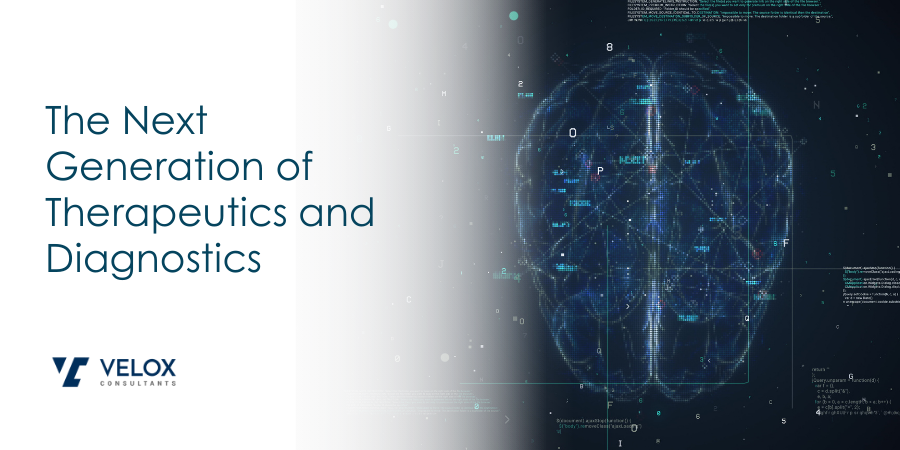Market Overview
Innovations in therapeutics and diagnostics are crucial in improving healthcare and patient care while offering significant business opportunities. Accelerated regulatory approvals and technological advancements help tackle pressing health issues and create new markets, ultimately improving patient recovery and quality of life. Personalised medicine, cost-saving prospects, and enhanced patient outcomes are benefits of investing in therapeutic and diagnostic innovation, which foster growth and sustainability in the ever-changing healthcare landscape.
The Global Digital Therapeutics Market is expected to be over US$20 Billion by 2030, with an estimated growth rate (CAGR) of more than 20% from 2024 to 2030.
The global market for therapeutics and diagnostics is experiencing rapid growth, driven by various factors such as technological advancements, an ageing population, increasing prevalence of chronic diseases, and rising healthcare expenditure. This growth presents significant opportunities for healthcare professionals and researchers, highlighting their essential role in shaping the future of healthcare.
Several key factors largely drive the expansion of the global therapeutics and diagnostics market:
- Ageing Population: The increasing number of people worldwide results in a higher occurrence of age-related ailments, which calls for innovative diagnostic and therapeutic solutions. The progress made in biotechnology, personalised medicine, and medical technology is essential in addressing these challenges effectively and ensuring improved healthcare outcomes for the elderly population.
- Rising Prevalence of Chronic Diseases: The prevalence of chronic diseases such as diabetes, cardiovascular diseases, and cancer is increasing globally, which has led to a growing demand for advanced therapeutic and diagnostic solutions. This trend emphasises the need for innovative healthcare technologies and strategies to manage and mitigate these conditions. As a result, the medical science industry is focusing its research efforts and resources on this growing market.
- Technological Advancements: Medical technology has evolved to include advanced diagnostic devices, wearables, and telehealth platforms that enhance accessibility and efficiency in healthcare diagnostics. These advancements have made it possible to detect and monitor health conditions early, leading to better patient outcomes and care delivery.
- Increased Healthcare Expenditure: As countries invest more in healthcare infrastructure and services, access to advanced medical interventions is expanding globally. This shift prioritises health and aims to enhance patient care and outcomes.
Market Challenges
Exploring the multifaceted realm of digital health technology can be daunting, as it involves a range of intricate challenges that require a thorough and strategic approach. These obstacles include navigating the complex web of regulatory compliance across various regions, making significant investments in research and development, assembling diverse expertise, and ensuring the utmost importance of safeguarding data privacy and security.
- Regulatory Hurdles: Understanding the complex landscape of regulations governing global digital health technology is crucial for businesses, as it helps them avoid costly mistakes and ensures a smooth market entry. Because the rules vary widely across different jurisdictions, strategic planning is necessary. Companies that seek to enter international markets face significant challenges, including time-consuming and expensive regulatory processes. Therefore, businesses should proactively engage with regulatory agencies to understand specific requirements and build collaborative relationships to manage these challenges effectively. Seeking guidance from regulatory consulting services is essential to navigate these intricate international standards. Moreover, adopting a flexible development approach allows adaptability to diverse regulatory environments, ensuring a smoother transition into global markets. This strategy minimises risks and facilitates compliance, enabling successful market penetration.
- High Research and Development Costs: The journey from imagination to commercialisation for digital health technologies can be long and expensive, involving extensive research, development, and regulatory approvals. This complexity can often cause startups and small companies to struggle. However, by partnering with established firms, startups can share the costs and gain valuable insights, which can help them overcome these challenges. Seeking targeted funding through government grants or venture capital designed to spur health tech innovation and implementing lean startup approaches to refine development and cut unnecessary spending are also effective strategies. These methods allow smaller entities to bridge the gap between concept and market and thrive in the competitive health technology landscape.
- Need for Interdisciplinary Expertise: Developing successful digital health solutions requires a combination of expertise from healthcare, technology, data science, and regulatory sectors. This makes it difficult to find and hire the right talent. To overcome this challenge, organisations should encourage interdisciplinary teamwork and continuous learning. Regular employee education and training will help to keep the workforce updated with the latest technological and regulatory advancements. Additionally, forming partnerships with academic entities, industry groups, and organisations can expand the available talent pool. This approach can simplify hiring and foster innovation and collaboration in the digital health industry.
- Data Privacy and Security Concerns: In today's rapidly evolving digital health landscape, safeguarding personal health information to maintain public trust is paramount. To mitigate the risks of data breaches and unauthorised access, it is essential to implement and continually update cutting-edge cybersecurity measures. Compliance with data protection laws such as Europe's GDPR and the US's HIPAA, enforced through strict internal audits and policies, is crucial. Building trust by transparently communicating with users about data use and protection practices is vital. These strategies are key to ensuring the security and privacy of health information in the digital era, thereby supporting the continued adoption of digital health technologies.
Adopting a strategic and proactive approach to overcome the digital health sector's challenges is important. This approach should consider regulatory complexities, research and development costs, interdisciplinary expertise, and data privacy and security. Companies can develop innovative and effective digital health solutions by implementing comprehensive strategies.
Emerging Business Trends and Impact of HealthTech
The intersection of emerging technologies and business trends significantly transforms the healthcare landscape, particularly in the diagnosis and therapeutic areas. Two notable trends leading this transformation are the increased collaboration between technology firms and pharmaceutical companies and the emergence of personalised medicine. These trends are not just driving innovation but also hold the potential to enhance patient outcomes significantly.
Rise of Personalised Medicine:
Personalised medicine, also called precision medicine, is a medical approach that customises treatment to suit the unique characteristics of each patient. This approach is more advanced than the traditional "one size fits all" strategy and considers genetic, environmental, and lifestyle factors to prevent, diagnose, and treat diseases more effectively.
The impact of personalised medicine on therapeutic and diagnostic solutions is profound:
- Enhanced Diagnostic Accuracy: Molecular diagnostics and genetic testing can help identify diseases more accurately by analysing them at a molecular level. This way, doctors can make more precise diagnoses.
- Targeted Therapies: Customising treatments based on a patient's genetic makeup can greatly improve drug effectiveness and reduce side effects.
- Predictive Tools: Healthcare providers can use genetic information to predict the likelihood of disease occurrence. This helps them take preventive measures or make early interventions.
- Cost-Effectiveness: Personalised medicine helps cut healthcare costs by targeting treatments to those who will benefit the most. This approach is more efficient as it avoids wasting resources on treatments that may not work.
Collaboration Between Pharmaceutical Companies and Technology Firms:
The collaboration between pharmaceutical companies and technology firms is another trend poised to transform the healthcare sector. This partnership leverages the strengths of both sectors to accelerate drug discovery, enhance drug development processes, and create innovative diagnostic tools.
Key impacts include:
- Data Analytics and AI: Technology companies have advanced tools that can analyse vast datasets using data analytics and artificial intelligence. These tools can identify potential drug candidates and predict their success rate.
- Digital Therapeutics: Software and digital tools are being developed to complement traditional medications and offer new therapeutic options for treating diseases. These tools can be used in addition to medication to help patients recover.
- Wearable Technologies: In real-time, wearable devices and mobile health applications can track patients' health conditions. This data can be used to create personalised treatment plans and enable remote monitoring of patients.
- Blockchain for Security and Transparency: Blockchain technology is being explored for securely managing patient data and tracking the pharmaceutical supply chain, enhancing transparency and safety.
The convergence of these trends signifies a shift towards a more patient-centric, efficient, and innovative healthcare ecosystem. However, it also presents challenges, such as regulatory hurdles, privacy concerns, and the need for significant investment in technology and training. As these trends evolve, the healthcare industry must navigate these challenges to realise the full benefits of next-generation therapeutics and diagnostics.
Impact of HealthTech:
Exploring cutting-edge therapeutics and diagnostics is a vast and rapidly evolving field, crucial for advancing healthcare outcomes and efficiencies. The intersection of technology, biology, and patient care has led to remarkable innovations.
Here are some key areas where recent advancements are revolutionising healthcare:
- Precision Medicine and Genomics: Technologies like CRISPR-Cas9 enable precise genetic modifications, promising cures for genetic diseases like sickle cell anaemia and some cancers. Concurrently, advancements and cost reductions in Whole Genome Sequencing facilitate personalised medicine, tailoring treatments to individuals' genetic profiles and enhancing healthcare effectiveness.
- Digital Health and Telemedicine: Wearable devices track vital signs and activity, supporting immediate health management. Meanwhile, telemedicine's growth enhances healthcare access, particularly in remote or underserved regions, by remotely linking patients with medical professionals.
- Artificial Intelligence and Machine Learning: AI algorithms enhance diagnostics by swiftly and accurately analysing patient data, including images and genetics, often surpassing human accuracy. In drug discovery, machine learning expedites the identification of new drugs by predicting molecular behaviour, significantly cutting down the development time and costs.
- Regenerative Medicine and Tissue Engineering: Stem cell therapy involves methods that turn stem cells into particular cell types to repair tissues, offering potential cures for ailments like diabetes and heart disease. Organ-on-a-chip technology uses tiny chips to mimic whole organs' functions, revolutionising drug testing and disease research by replicating human physiological responses.
- Immunotherapy and Advanced Therapeutics: CAR-T cell therapy enhances patient T-cells for improved cancer attack, showing significant success in some leukaemias. Biosimilars and biobetters, akin or superior to original biologics, expand treatment choices and lower healthcare expenses.
- Nanomedicine: Nanotechnology enhances drug delivery, specifically targeting and minimising side effects. This approach significantly boosts treatment effectiveness by engineering nanoparticles to carry medications directly to affected cells. This advancement allows for more efficient therapies, ensuring that drugs reach their intended destinations within the body more accurately.
- Robotics and Minimally Invasive Surgery: Surgical robots enhance precision in surgeries, making them less invasive. This shortens recovery periods and improves outcomes. Rehabilitation robots support patient recovery, aiding in restoring motor skills and strength. These robots use adaptive algorithms to tailor therapy sessions to individual patient needs, improving effectiveness.
Key Use Cases
The next generation of therapeutics and diagnostics represents a leap forward in personalised medicine, offering more precise, effective, and less invasive treatments and tools for disease management. These innovations span various fields, including genetic editing, wearable technology, and advanced genomic sequencing.
Here's a closer look at these advancements:
Innovative Therapeutics:
- CRISPR Gene Editing: The CRISPR-Cas9 technology has brought about a significant change in the field of genetic engineering. It has enabled precise editing of DNA sequences to rectify mutations that cause genetic disorders. This advancement has opened new avenues for treating previously deemed incurable ailments. For instance, clinical trials are underway to employ CRISPR to treat sickle cell disease, a genetic condition impacting millions of people worldwide. By correcting the gene responsible for the disorder, CRISPR has the potential to provide a one-time cure that lasts a lifetime.
- RNA-based Therapies: RNA-based therapies, such as mRNA vaccines, have gained significant attention, particularly due to their vital role in combating the COVID-19 pandemic. These therapies use RNA to direct cells to generate proteins that stimulate the immune system to fight against diseases or rectify genetic abnormalities. This approach has emerged as a promising alternative to CRISPR gene editing technology.
- Targeted Cancer Therapies: New therapies have been developed targeting specific genes or proteins contributing to cancer growth. This approach offers more precise treatment options compared to traditional chemotherapy. One example is CAR-T cell therapy, which involves modifying a patient's T-cells to attack cancer cells. This treatment has shown remarkable success in treating certain types of leukaemia.
Non-Invasive Diagnostic Tools:
- Wearable Sensors: The field of wearable technology has made remarkable progress in continuous health monitoring. Modern devices such as smartwatches and fitness trackers come equipped with sensors that can track vital signs like heart rate and blood oxygen levels and even detect irregular heartbeats. These tools enable individuals to keep track of their health in real time, which can result in early detection and treatment of various conditions.
- Liquid Biopsies: This revolutionary diagnostic technique enables the identification of cancer and other illnesses through a straightforward blood test. It detects DNA fragments discharged by tumours or other signs of disease. Liquid biopsies provide a less invasive alternative to conventional biopsy procedures, with the potential for the early identification and monitoring of disease progression.
Companies Leading Advancements:
- Illumina in Genomic Sequencing: Illumina has been instrumental in reducing the cost of genomic sequencing, making it more accessible for research and clinical applications. This development has been crucial for advancing personalised medicine, making it possible to provide more accurate diagnoses and treatment plans based on an individual's genetic makeup. Illumina's sequencing technology has played a significant role in cancer genomics, rare disease diagnosis, and prenatal testing, among other applications.
- CRISPR Therapeutics and Editas Medicine – Pioneers in Gene Editing: Two companies are at the forefront of developing gene therapies using CRISPR technology. As mentioned earlier, CRISPR Therapeutics and Vertex Pharmaceuticals have teamed up to investigate sickle cell disease and beta-thalassemia treatments. Meanwhile, Editas Medicine is concentrating on developing CRISPR-based therapies for eye diseases, blood disorders, and cancer.
The Indian Market
The Indian therapeutics and diagnostics sector is experiencing significant growth thanks to innovation and strong government support. The government's strategic policies and initiatives are essential in improving healthcare outcomes and strengthening the nation's biotechnological landscape.
In recent years, the government has increased its efforts to encourage research and development in therapeutics and diagnostics. Establishing the National Biopharma Mission and the Biotechnology Industry Research Assistance Council (BIRAC) demonstrates a concerted effort to support biotech startups and enterprises through financial aid and strategic guidance. These initiatives aim to accelerate the journey from research discovery to market-ready products, strengthening India's pharmaceutical and diagnostics capabilities.
The National Digital Health Mission (NDHM) is an ambitious initiative to transform healthcare delivery in India by integrating technology and data analytics. The primary objective of this mission is to establish a unified digital health ecosystem, which would make medical services more accessible and promote the use of advanced diagnostic tools and telehealth services. The NDHM has the potential to revolutionise the Indian healthcare sector and make it more efficient, effective, and patient-centric.
Indian startups and corporations are leading in innovation, particularly therapeutics and diagnostics. The success of entities like Mylab Discovery Solutions, which gained global recognition for its indigenous COVID-19 testing kits, and the progress achieved in novel therapeutic development by companies such as Biocon and Sun Pharma are evidence of India's position as a pharmaceutical innovation powerhouse.
The future of India's therapeutics and diagnostics industry looks promising. Ongoing investment in research and development, coupled with supportive policy frameworks, is expected to lead to more innovation and growth within the industry. With a large pool of talented researchers and established manufacturing facilities, India is well-positioned to take advantage of emerging opportunities in precision medicine and tailored diagnostics.
India's therapeutics and diagnostics industry is experiencing significant growth, driven by favourable regulations, government support, and a thriving network of startups and businesses. With the strategic use of innovation and technology, India is poised to become a leading player in the global healthcare sector. It is well-equipped to meet the healthcare needs of its people while also contributing to the advancement of medical science worldwide.
Our Perspective
The development of treatments and tools for detecting illnesses marks a significant turning point in the history of medicine. It highlights a dramatic improvement in healthcare capabilities and a fundamental shift in how we approach patient care. As we approach this new era, the future direction of these fields is being influenced more and more by sustainability and ethics, as well as by the constant quest for scientific advancements.
- Sustainability and Ethical Considerations: Integrating sustainability into therapeutics and diagnostics means recognising the close relationship between environmental and human health. This shift in thinking requires us to develop treatment and diagnostic tools with minimal environmental impact. This involves reducing the carbon footprint of manufacturing processes and using biodegradable materials. Ethical considerations are also crucial, especially in genetics and personalised medicine. As we gain the ability to predict and prevent diseases, concerns about data privacy, consent, and the potential for genetic discrimination become more significant. Ensuring everyone has access to these technologies, regardless of their economic status, is also an essential ethical issue highlighting the need for fair healthcare solutions.
- Collaboration Across the Healthcare Ecosystem: The challenges we face in healthcare are complex and require a collaborative approach. This means bringing together stakeholders from various sectors, such as researchers, healthcare providers, patients, regulatory bodies, and the pharmaceutical industry. By promoting open communication and cooperation, we can ensure that the development of new therapeutics and diagnostics is informed by diverse perspectives, leading to better results. Collaborative platforms can also speed up innovation by allowing the sharing of data and resources, which can spark breakthroughs in treatment and diagnosis.
- Harnessing Emerging Technologies: Technologies like AI and machine learning, nanotechnology, and CRISPR gene editing can potentially completely transform the fields of therapeutics and diagnostics. AI and machine learning can help improve diagnostic accuracy, customise treatments for individual patients, and identify new therapeutic targets. Nanotechnology can deliver drugs more efficiently with fewer side effects, while CRISPR can cure genetic diseases right from the source. However, to fully realise the potential benefits of these technologies, we must focus on technical innovation, ethical guidance, and regulatory frameworks that ensure their responsible use for the greater good.
The importance of innovation in therapeutics and diagnostics cannot be overstated. It drives us towards a future where healthcare is more personalised, effective, and fair. However, we must navigate this journey with an awareness of the ethical implications and a commitment to sustainability. By adopting a collaborative approach that involves all stakeholders in the healthcare ecosystem, we can overcome existing challenges and fully utilise the potential of emerging technologies. This way, we ensure that the next generation of therapeutics and diagnostics advances medical science and upholds the principles of equity and environmental stewardship. This is our perspective, commitment, and promise for the future of healthcare.
Velox Consultants is one of the fastest-growing market research and strategy consulting firms, recently recognised by Clutch. We specialise in providing customised research reports and Go-to-Market (GTM) strategies that cater to the specific needs of companies in the healthcare and pharma industry.
Our team of highly skilled professionals is well-equipped to help your company stay ahead in such a dynamic and competitive market. Explore how healthcare and pharma products, from large corporations to aspiring entrepreneurs, can revolutionise your business. Please get in touch with us at consult@veloxconsultants.com.





